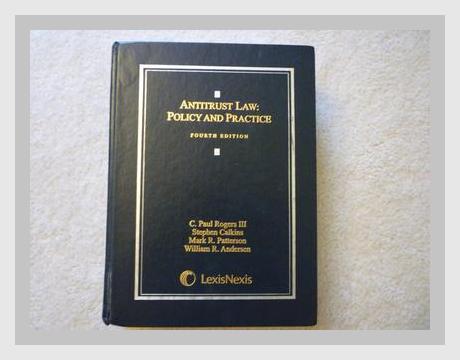Business Law and EthicsAntitrust Laws
**
Introduction
The book Antitrust Law: Policy and Practice by C. Paul Rogers, Stephen Calkins, Mark R. Patterson, and William R. Andersen, published in 2013, provides an in-depth examination of antitrust laws in the United States. It explores the history, principles, and practical application of antitrust regulations, aimed at maintaining fair competition and preventing monopolies. The book is structured to help practitioners, students, and businesses understand how antitrust laws affect various market activities. This summary provides a concise overview of the book’s key points, enriched with concrete examples and actionable advice.
1. Historical Background and Fundamental Concepts
The authors begin by outlining the development of antitrust laws, focusing on the Sherman Act of 1890, the Clayton Act of 1914, and the Federal Trade Commission Act of 1914. These laws form the bedrock of antitrust policy in the US.
- Actionable Step: Stay informed about the evolution of antitrust laws by revisiting historical cases and legislative changes.
Example: The Sherman Act was used to break up Standard Oil into smaller companies in 1911, reshaping the oil industry and setting a precedent for handling monopolistic practices.
2. The Sherman Act: Section 1
Section 1 of the Sherman Act prohibits contracts, combinations, or conspiracies that restrain trade. The book discusses both per se violations and the rule of reason standard, which evaluates whether a practice is an unreasonable restraint on competition.
- Actionable Step: Assess business agreements with competitors to ensure they don’t fall into per se illegal activities like price-fixing or market division.
Example: The case of United States v. Socony-Vacuum Oil Co. where horizontal price-fixing was deemed per se illegal.
3. The Sherman Act: Section 2
Section 2 addresses monopolization and attempts to monopolize. The book emphasizes the need to differentiate between aggressive competition (which is good for consumers) and anticompetitive practices.
- Actionable Step: Review your company’s market behavior and competitive strategies to ensure compliance with antitrust laws.
Example: The landmark case of United States v. Microsoft Corp., where Microsoft’s practices were scrutinized for maintaining its monopoly in personal computer operating systems through anticompetitive means.
4. The Clayton Act and its Provisions
The Clayton Act aims to promote fair competition by addressing specific practices like price discrimination, exclusive dealings, mergers, and acquisitions that may lead to anticompetitive outcomes.
- Actionable Step: When planning mergers or acquisitions, conduct a thorough antitrust analysis to understand the potential competitive effects.
Example: The merger of AT&T and T-Mobile faced significant antitrust scrutiny and was challenged under the Clayton Act due to concerns about reduced competition.
5. The Role of the Federal Trade Commission (FTC)
The FTC enforces antitrust laws and prevents unfair methods of competition. The book describes the FTC’s authority and investigative processes.
- Actionable Step: Ensure all business practices align with FTC regulations to avoid investigations or sanctions.
Example: The FTC’s challenge of the merger between Procter & Gamble and Clorox in the 1950s, citing potential harm to competition in the household bleach market.
6. Horizontal and Vertical Restraints
The distinction between horizontal restraints (agreements among competitors) and vertical restraints (agreements between different levels of the supply chain) is crucial. The authors explain how different levels of scrutiny apply.
- Actionable Step: Before entering agreements with other companies, determine if they are horizontal or vertical to understand the legal implications.
Example: Vertical price restrictions were at the center of Leegin Creative Leather Products, Inc. v. PSKS, Inc., where the Supreme Court applied the rule of reason to vertical price fixing.
7. Antitrust Procedures and Litigation
The book dives into procedural aspects, including how antitrust cases are investigated, litigated, and resolved. It covers both private actions and government enforcement.
- Actionable Step: Develop a compliance program and antitrust policy to be prepared for potential investigations or litigation.
Example: Private plaintiff actions such as class actions against price-fixing conspiracies, which can lead to significant damages, as seen in the case of Price-Fixing Libor Settlement.
8. Intellectual Property and Antitrust
The intersection of antitrust and intellectual property (IP) laws is explored, especially in relation to patent misuse and IP licensing practices.
- Actionable Step: Carefully structure IP licenses and agreements to avoid antitrust violations.
Example: The FTC v. Qualcomm Inc. case where Qualcomm’s licensing practices were deemed anticompetitive due to their “no license, no chips” policy.
9. International Antitrust Issues
Globalization necessitates an understanding of how US antitrust laws interact with international regulations, especially for multinational companies.
- Actionable Step: When operating internationally, ensure compliance with both US and foreign antitrust regulations to avoid conflicts and penalties.
Example: The GE-Honeywell merger was blocked by the European Commission, highlighting differing antitrust perspectives between the US and the EU.
10. Policy Debates in Antitrust Law
The authors address contemporary debates, such as whether antitrust laws should prioritize consumer welfare or consider broader issues like market fairness and economic democracy.
- Actionable Step: Stay updated on ongoing policy debates to anticipate and adapt to potential changes in antitrust enforcement.
Example: The changing approach to Big Tech companies, where there is increasing scrutiny on market dominance and data privacy concerns.
Conclusion
Antitrust Law: Policy and Practice provides a comprehensive guide to understanding and navigating the complexities of antitrust laws. By adhering to the principles and practices outlined in the book, individuals and businesses can ensure compliance and actively contribute to maintaining competitive market environments. Each section of the book highlights practical steps that can be taken to align with antitrust regulations, demonstrating the relevance of these laws in contemporary business practices.
